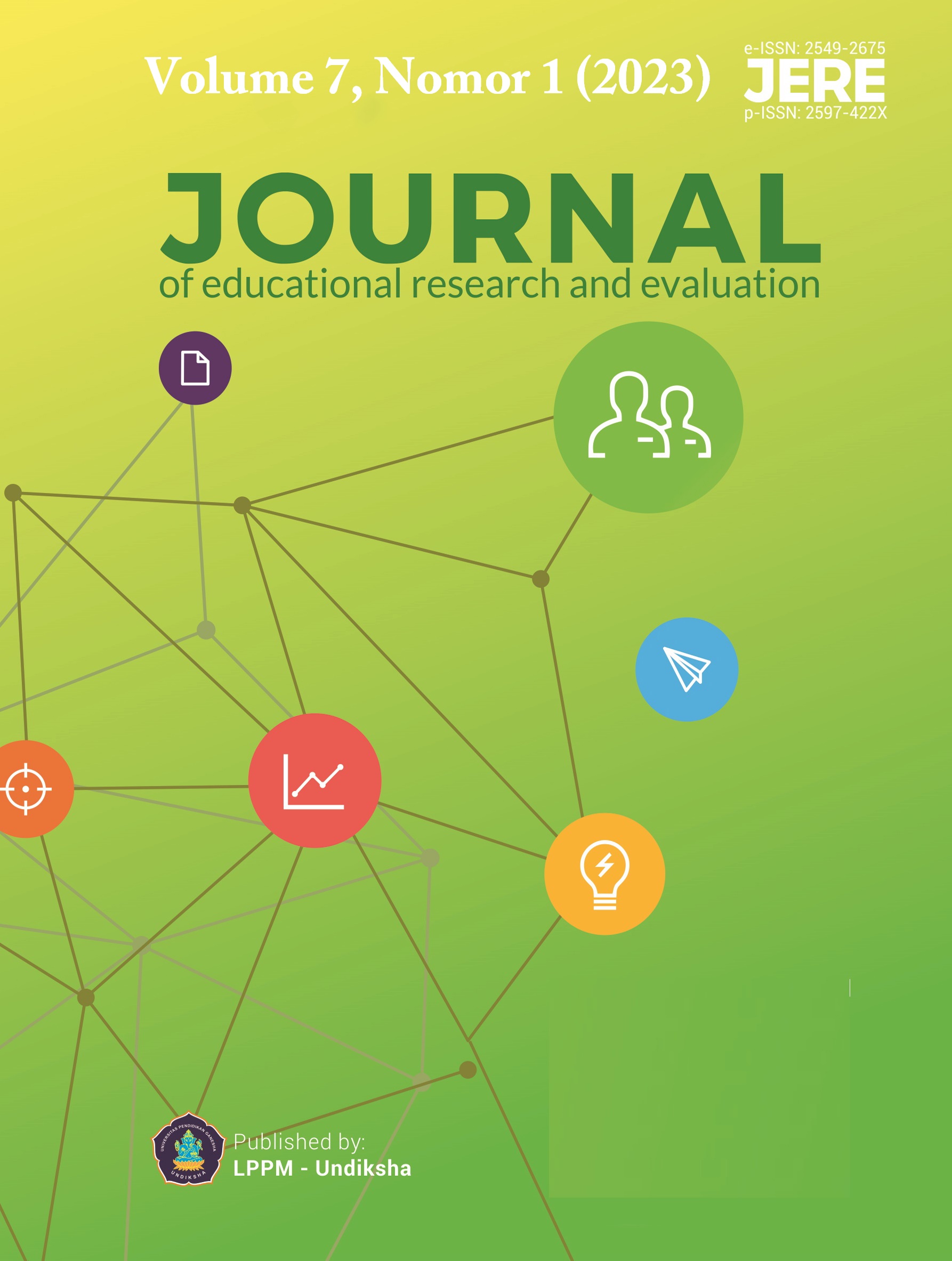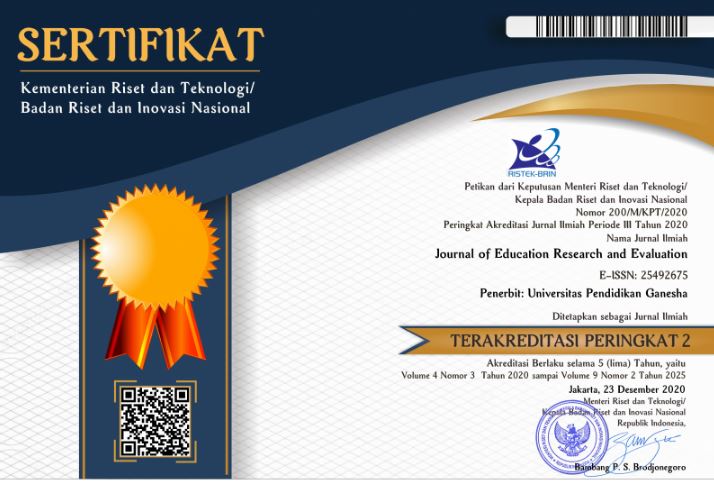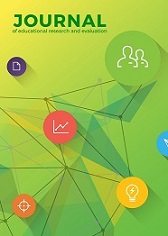Development of Rational Function Integral E-Worksheet with Linear Factor Denominators to Improve Mathematical Creative Thinking Ability
DOI:
https://doi.org/10.23887/jere.v7i1.54238Keywords:
Creative, Development, Rational IntegralAbstract
There is no electronic worksheet that can help students to optimize their mathematical creative thinking skills in the Integral Integration technique of rational functions with the denominator is a linear factor being the background for this research. This research aims to produce an e-worksheet that can be used in integral calculus courses, especially material for Integral Integration techniques of rational functions with the denominators being linear factors, and can improve the ability to think creatively mathematically. The research was conducted using the ADDIE development model. The research subjects were 15 students of Mathematics Education at the University of Riau. Data collection instruments used questionnaires and tests with quantitative and qualitative descriptive analysis. From the calculation of the validation score, overall, the e-worksheet is valid and can be used by Mathematics Education students in Integral Calculus courses. Based on the results of the second student response questionnaire, the e-worksheet met the practical criteria with the achievement of e-worksheet 1 of 83.33% and e-worksheet 2 of 76.3%. From the results of the worksheet effectiveness test, there has been an increase in students' mathematical creative thinking ability after using e-worksheet from 2.73 to 7.6 and is in the medium category. Referring to the results of this study means that the developed e-worksheet is feasible to use and can improve students' mathematical creative thinking abilities.
References
Afandi, A., & Jalal, A. (2017). Pengembangan LKM Dengan Pendekatan Open-Ended Untuk Meningkatkan Kemampuan Berpikir Kreatif Pada Mata Kuliah Geometri. Delta-Pi: Jurnal Matematika Dan Pendidikan Matematika, 6(2), 1–8. https://doi.org/http://dx.doi.org/10.33387/dpi.v6i2.1147.
Akbar, S. (2017). Instrumen Perangkat Pembelajaran. Remaja Rosdakarya.
Amidi. (2018). Kemampuan Berpikir Kreatif Mahasiswa Semester 1 pada Mata Kuliah Matematika Dasar. Prisma, Prosiding Seminar Nasional Matematika, 1, 936–942. https://journal.unnes.ac.id/sju/index.php/prisma/article/view/20642.
Anggitasari, M., Tarwana, W., Febriani, R. B., & Syafryadin, S. (2020). Using Wattpad to Promote the Students’ Responses to Literary Works: EFL College Students’ Perspectives and Experiences of Enjoying Short Stories. Jadila: Journal of Development and Innovation in Language and Literature Education, 1(2), 182–192. https://doi.org/10.52690/jadila.v1i2.59.
Annisah, S., Zulela, Z., & Boeriswati, E. (2020). Analysis of student needs for mathematics teaching materials. International Conference on Innovation in Research, 1469(1), 1–8. https://doi.org/10.1088/1742-6596/1469/1/012156.
Arhasy, E. A., & Mulyani, E. (2017). Kontribusi Model Problem Based Learning Berbantuan Media Software Maple Terhadap Kemampuan Berpikir Kreatif Matematis dan Self Regulated Learning Mahasiswa. Jurnal Siliwangi, 3(1), 197–203. https://doi.org/10.37058/jspendidikan.v3i1.190.
Ariawan, R., & Nufus, H. (2017). Profil Kemampuan Koneksi Matematis Mahasiswa dalam Menyelesaikan Masalah pada Mata Kuliah Kalkulus 1 ditinjau berdasarkan Gaya Kognitif. Suska Journal of Mathematics Education, 3(2), 102. https://doi.org/10.24014/sjme.v3i2.4036.
Assagaf, G. (2016). Pengaruh kemandirian belajar dan regulasi diri terhadap hasil belajar matematika melalui motivasi berprestasi pada siswa kelas X SMA Negeri di Kota Ambon. Matematika Dan Pembelajaranya, 2(1), 105–126. https://jurnal.iainambon.ac.id/index.php/INT/article/download/306/238.
Carayannis, E. G., & Morawska-Jancelewicz, J. (2022). The Futures of Europe: Society 5.0 and Industry 5.0 as Driving Forces of Future Universities. Journal of the Knowledge Economy, 0123456789. https://doi.org/10.1007/s13132-021-00854-2.
Dharmawan, K., Ramona, Y., Rupiasih, N., & Nilakusmawati, D. P. E. (2015). Pemanfaatan aplikasi Google Docs sebagai media pembinaan Karya Ilmiah Remaja. Prosiding Seminar Nasional Ilmu Komputer Dan Teknologi Informasi, 45–48. https://www.researchgate.net/profile/desak-putu-nilakusmawati/publication/285482658.
Dwijayani, N. M. (2019). Development of circle learning media to improve student learning outcomes. Journal of Physics: Conference Series, 1321(2), 171–187. https://doi.org/10.1088/1742-6596/1321/2/022099.
Fajarianingtyas, D. A., Akbar, N. A., & Herowati. (2019). Cell as the system of life: Student’s worksheet development through scientific approach. Biosfer: Jurnal Pendidikan Biologi, 12(1), 109–121. https://doi.org/10.21009/biosferjpb.v12n1.109-121.
Farman, Hali, F., & Rawal, M. (2021). Development of E-LKPD Using Live Worksheets for Online Mathematics Learning during Covid-19. Jurnal of Mathematics Education, 6(1), 36–42. https://doi.org/https://doi.org/10.31327/jme.v6i1.1626.
Fathimah, S., Sidik, S., & Rahman, R. (2020). Google Docs sebagai solusi pengerjaan tugas kelompok dalam Pembelajaran Daring di tengah pandemi Covid 19. JISIP (Jurnal Ilmu Sosial Dan Pendidikan), 4(3), 273–279. https://doi.org/10.36312/jisip.v4i3.1207.
Febriani, M. (2016). Pemanfaatan Lembar Kerja Mahasiswa untuk meningkatkan keaktifan mahasiswa: Studi penerapan Lesson Study pada mata kuliah Buku Teks Pelajaran Bahasa Indonesia. Jurnal Pendidikan Bahasa Dan Sastra, 16(2), 203. https://doi.org/10.17509/bs_jpbsp.v16i2.4482.
Handayani, N. F., & Mahrita. (2020). Faktor Penyebab Kesulitan Belajar Matematika Pada Siswa Kelas IV di SDN Jawa 2 Martapura Kabupaten Banjar. Jurnal PTK & Pendidikan, 6(2), 40–48. https://doi.org/10.18592/ptk.v6i2.4045.
Huljannah, M., Sa’dijah, C., & Qohar, A. (2018). Profil Berpikir Kreatif Matematis Mahasiswa Pendidikan Guru Sekolah Dasar. Jurnal Pendidikan: Teori, Penelitian, Dan Pengembangan, 3(11), 1428–1433. https://doi.org/http://dx.doi.org/10.17977/jptpp.v3i11.11730.
Istikomah, I., & Purwoko, R. Y. (2020). Pengembangan E-Modul Matematika Berbasis Realistik Untuk Meningkatkan Kemampuan Berpikir Kreatif Siswa. MAJU : Jurnal Ilmiah Pendidikan Matematika, 7(2), 63–71. https://ejournal.stkipbbm.ac.id/index.php/mtk/article/viewFile/490/438.
Kamarullah. (2017). Pendidikan matematika di sekolah kita. Al Khawarizmi: Jurnal Pendidikan Dan Pembelajaran Matematika, 1(1), 21–32. https://doi.org/10.22373/jppm.v1i1.1729.
Kholil, M., & Zulfiani, S. (2020). Faktor-Faktor Kesulitan Belajar Matematika Siswa Madrasah Ibtidaiyah Da’watul Falah Kecamatan Tegaldlimo Kabupaten Banyuwangi. EDUCARE: Journal of Primary Education, 1(2), 151–168. https://doi.org/10.35719/educare.v1i2.14.
Nurdin, E., Herlina, R., Risnawati, R., & Granita, G. (2019). Pengembangan Lembar Kerja Siswa Berbasis Pendekatan Open-Ended untuk Memfasilitasi Kemampuan Berpikir Kreatif Matematis Siswa Madrasah Tsanawiyah. Jurnal Mercumatika: Jurnal Penelitian Matematika Dan Pendidikan Matematika, 4(1), 21–31. https://doi.org/10.26486/jm.v4i1.500.
Nurrita, T. (2018). Pengembangan Media Pembelajaran Untuk Meningkatkan Hasil Belajar Siswa. Journal of Physics: Conference Series, 03(2), 171–187. https://doi.org/10.1088/1742-6596/1321/2/022099.
Pasandaran, R., Kartika, D. M. R., & Masni, E. D. (2017). Pengembangan Lembar Kerja Mahasiswa (LKM) pada pembuktian Dalil-Dalil Segitiga. Prosiding Seminar Nasional Universitas Cokroaminoto Palopo, 3(1), 147–153. https://doi.org/https://www.journal.uncp.ac.id/index.php/proceding/article/view/783/669.
Sarassanti, Y., & Mutazam. (2019). Analisis Kemampuan Berpikir Kreatif Matematis Mahasiswa PGSD pada Materi Bangun Ruang di STKIP Melawi. Jurnal Pendidikan Dasar, 7(2), 133–139. https://doi.org/10.46368/jpd.v7i2.168.
Septinawati, S., Febriani, R. B., Tarwana, W., & Syafryadin, S. (2020). Students’ Perceptions Toward the Implementation of Quipper School as an E-Learning Platform in Teaching English. Jadila: Journal of Development and Innovation in Language and Literature Education, 1(2), 223–238. https://doi.org/10.52690/jadila.v1i2.103.
Siregar, H. M. (2019). Analisis Kesalahan Siswa Dalam Menyelesaikan Soal Tes Kemampuan Berpikir Kreatif Matematis Materi Lingkaran. AKSIOMA: Jurnal Program Studi Pendidikan Matematika, 8(3), 497–507. https://doi.org/10.24127/ajpm.v8i3.2379.
Siregar, H. M., & Siregar, S. N. (2021). Profil Self Regulation Mahasiswa Pendidikan Matematika FKIP Universitas Riau di Masa Pandemi Covid-19. ANARGYA: Jurnal Ilmiah Pendidikan Matematika, 4(1), 1–10. https://doi.org/10.24176/anargya.v4i1.5601.
Siregar, H. M., Solfitri, T., & Siregar, S. N. (2022). Development of E-Worksheet of Integration Technique Rational Functions Different Linear Factors to Improve Mathematical Creative Thinking Skills. 2021 Universitas Riau International Conference on Education Technology (URICET-2021), 35–40. https://ices.prosiding.unri.ac.id/index.php/ICES/article/view/7975.
Skobelev, P. O., & Borovik, S. Y. (2017). On The Way from Industry 4.0 To Industry 5.0: From Digital Manufacturing To Digital Society. On The Way from Industry 4.0 To Industry 5.0: From Digital Manufacturing To Digital Society, 2(6), 307–311. https://stumejournals.com/journals/i4/2017/6/307.
Solfitri, T., & Siregar, H. M. (2021). Developing integration techniques module to improve mathematical creative thinking ability in Integral Calculus. Jurnal PAJAR (Pendidikan Dan Pengajaran), 5(2), 296–305. https://doi.org/http://dx.doi.org/10.33578/pjr.v5i2.8221.
Subekti, F. E., & Akhsani, L. (2020). Pengembangan Modul Statistika Deskriptif Berbasis Pemecahan Masalah. AKSIOMA: Jurnal Program Studi Pendidikan Matematika, 9(3), 530–539. https://doi.org/10.24127/ajpm.v9i3.2869.
Suryaningtyas, A., Kimianti, F., & Prasetyo, Z. K. (2020). Developing Science Electronic Module Based on Problem-Based Learning and Guided Discovery Learning to Increase Critical Thinking and Problem-Solving Skills. 401(Iceri 2019), 65–70. https://doi.org/10.2991/assehr.k.200204.013.
Suryawati, E., Suzanti, F., Zulfarina, Putriana, A. R., & Febrianti, L. (2020). The implementation of local environmental problem-based learning student worksheets to strengthen environmental literacy. Jurnal Pendidikan IPA Indonesia, 9(2), 169–178. https://doi.org/10.15294/jpii.v9i2.22892.
Susiaty, U. D. (2018). Aktivitas Dan Respon Siswa Melalui Model Pembelajaran Within-Solution Posing. Buana Matematika : Jurnal Ilmiah Matematika Dan Pendidikan Matematika, 8(1:), 25–30. https://doi.org/10.36456/buana_matematika.8.1:.1520.25-30.
Sutrimo, S., Kamid, K., & Saharudin, S. (2019). LKPD Bermuatan Inquiry dan Budaya Jambi: Efektivitas dalam Meningkatkan Kemampuan Berpikir Kreatif Matematis. IndoMath: Indonesia Mathematics Education, 2(1), 29. https://doi.org/10.30738/indomath.v2i1.3841.
Syafryadin, Pratiwi, V. U., & Wardhana, D. E. C. (2021). Pre-service english teachers’ experience with various call applications: Hindrances and reflection. Studies in English Language and Education, 8(1), 99–114. https://doi.org/10.24815/siele.v8i1.17609.
Tonra, W. S., & Salim, A. (2018). Pengembangan Lembar Kegiatan Mahasiswa (LKM) Kalkulus Berbantuan Software Geogebra untuk Meningkatkan Kemampuan Spasial. SAINTIFIK, 4(2), 156–166. https://doi.org/10.31605/saintifik.v4i2.181.
Downloads
Published
How to Cite
Issue
Section
License
Copyright (c) 2023 Titi Solfitri, Hesty Marwani Siregar, Syofni, Rini Dian Anggraini, Ivo Apristi

This work is licensed under a Creative Commons Attribution-ShareAlike 4.0 International License.
Authors who publish with the Journal of Evaluation and Research in Education (JERE) agree to the following terms:
- Authors retain copyright and grant the journal the right of first publication with the work simultaneously licensed under a Creative Commons Attribution License (CC BY-SA 4.0) that allows others to share the work with an acknowledgment of the work's authorship and initial publication in this journal.
- Authors are able to enter into separate, additional contractual arrangements for the non-exclusive distribution of the journal's published version of the work (e.g., post it to an institutional repository or publish it in a book), with an acknowledgment of its initial publication in this journal.
- Authors are permitted and encouraged to post their work online (e.g., in institutional repositories or on their website) prior to and during the submission process, as it can lead to productive exchanges, as well as earlier and greater citation of published work. (See The Effect of Open Access)











